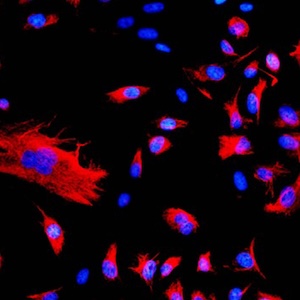 Smart Citations
Smart CitationsSee how this article has been cited at scite.ai
scite shows how a scientific paper has been cited by providing the context of the citation, a classification describing whether it supports, mentions, or contrasts the cited claim, and a label indicating in which section the citation was made.
SNORA38B promotes proliferation, migration, invasion and epithelial-mesenchymal transition of gallbladder cancer cells via activating TGF-β/Smad2/3 signaling
Evidence has shown that small nucleolar RNAs (snoRNAs) participate in the tumorigenesis in multiple cancers, including gallbladder cancer (GBC). Our results showed that SNORA38B level was increased in GBC tissues compared to adjacent normal tissues. Thus, this research aimed to explore the role and molecular mechanisms of SNORA38B in GBC. SNORA38B level between normal and GBC tissues was evaluated by RT-qPCR. Cell proliferation, apoptosis, migration, and invasion were tested by EdU assay, TUNEL staining and transwell assay, respectively on human intrahepatic biliary epithelial cells (HIBEpiCs) and the GBC cell lines, NOZ and GBC-SD. Expression of proteins in GBC cells was evaluated by immunofluorescence and Western blot assays. We found that, relative to normal tissues, SNORA38B level was notably elevated in GBC tissues. SNORA38B overexpression obviously enhanced GBC cell proliferation, migration, invasion and epithelial-mesenchymal transition (EMT), but weakened cell apoptosis. Conversely, SNORA38B downregulation strongly suppressed the proliferation and EMT of GBC cells and induced cell apoptosis and ferroptosis, whereas these phenomena were obviously reversed by TGF-β. Meanwhile, SNORA38B downregulation notably reduced the levels of phosphorylated-Smad2 and phosphorylated-Smad3 in GBC cells, whereas these levels were elevated by TGF-β. Collectively, downregulation of SNORA38B could inhibit GBC cell proliferation and EMT and induce ferroptosis via inactivating TGF-β1/Smad2/3 signaling. These findings showed that SNORA38B may be potential target for GBC treatment.
Edited by
all procedures were approved by the Ethics Committee of the Yancheng Third People's HospitalSupporting Agencies
Jiangsu Provincial Commission of Health and Family Planning, Jiangsu Province “333 High-level Talents Cultivating Project"How to Cite

This work is licensed under a Creative Commons Attribution-NonCommercial 4.0 International License.
PAGEPress has chosen to apply the Creative Commons Attribution NonCommercial 4.0 International License (CC BY-NC 4.0) to all manuscripts to be published.








